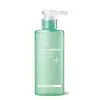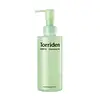What's inside
What's inside
 Key Ingredients
Key Ingredients

No key ingredients
 Benefits
Benefits

 Concerns
Concerns

 Ingredients Side-by-side
Ingredients Side-by-side

Water
Skin ConditioningPotassium Laureth Phosphate
EmulsifyingGlycerin
HumectantPotassium Cocoyl Glutamate
Acrylates/C10-30 Alkyl Acrylate Crosspolymer
Emulsion StabilisingButylene Glycol
HumectantAspartic Acid
MaskingSodium Cocoyl Glutamate
CleansingLauryl Hydroxysultaine
CleansingCoco-Glucoside
CleansingCaprylyl Glycol
EmollientGlyceryl Caprylate
EmollientPolyglyceryl-10 Laurate
Skin ConditioningCitrus Aurantium Dulcis Peel Oil
MaskingPolyglyceryl-10 Myristate
Skin ConditioningLavandula Angustifolia Oil
MaskingSodium Cocoyl Isethionate
CleansingDisodium EDTA
1,2-Hexanediol
Skin ConditioningQuillaja Saponaria Bark Extract
CleansingBifida Ferment Lysate
Skin ConditioningLactobacillus
Skin ConditioningLeuconostoc/Radish Root Ferment Filtrate
AntimicrobialMaltodextrin
AbsorbentMoringa Oleifera Seed Extract
Skin ConditioningOlea Europaea Oil Unsaponifiables
Skin ConditioningGlycine Soja Oil Unsaponifiables
EmollientTriticum Vulgare Germ Oil Unsaponifiables
EmollientPollen Extract
EmollientTheanine
EmollientMilk Lipids
Skin ConditioningGlutathione
Water, Potassium Laureth Phosphate, Glycerin, Potassium Cocoyl Glutamate, Acrylates/C10-30 Alkyl Acrylate Crosspolymer, Butylene Glycol, Aspartic Acid, Sodium Cocoyl Glutamate, Lauryl Hydroxysultaine, Coco-Glucoside, Caprylyl Glycol, Glyceryl Caprylate, Polyglyceryl-10 Laurate, Citrus Aurantium Dulcis Peel Oil, Polyglyceryl-10 Myristate, Lavandula Angustifolia Oil, Sodium Cocoyl Isethionate, Disodium EDTA, 1,2-Hexanediol, Quillaja Saponaria Bark Extract, Bifida Ferment Lysate, Lactobacillus, Leuconostoc/Radish Root Ferment Filtrate, Maltodextrin, Moringa Oleifera Seed Extract, Olea Europaea Oil Unsaponifiables, Glycine Soja Oil Unsaponifiables, Triticum Vulgare Germ Oil Unsaponifiables, Pollen Extract, Theanine, Milk Lipids, Glutathione
Water
Skin ConditioningGlycerin
HumectantSodium Cocoyl Alaninate
Lauryl Glucoside
CleansingLauryl Hydroxysultaine
CleansingCoco-Betaine
CleansingDisodium Cocoamphodiacetate
CleansingCentella Asiatica Extract
CleansingMadecassoside
AntioxidantAsiaticoside
AntioxidantAsiatic Acid
Skin ConditioningMadecassic Acid
Skin ConditioningPanthenol
Skin ConditioningCapryloyl Salicylic Acid
ExfoliatingCeramide NP
Skin ConditioningAllantoin
Skin ConditioningHamamelis Virginiana Extract
AntiseborrhoeicAlthaea Rosea Flower Extract
Skin ConditioningNymphaea Caerulea Flower Extract
Skin ConditioningSwertia Japonica Extract
Skin ConditioningLactobacillus Ferment
Skin ConditioningGlycine Soja Seed Extract
Skin ConditioningQuillaja Saponaria Bark Extract
CleansingAloe Ferox Leaf Extract
Skin ConditioningButylene Glycol
HumectantPentylene Glycol
Skin ConditioningHexylene Glycol
EmulsifyingCoco-Glucoside
CleansingSodium Chloride
MaskingSodium Cocoyl Isethionate
CleansingCaprylyl Glycol
EmollientCaprylic/Capric Triglyceride
MaskingOctanediol
Acrylates/C10-30 Alkyl Acrylate Crosspolymer
Emulsion StabilisingHydrogenated Lecithin
EmulsifyingMelia Azadirachta Leaf Extract
Skin ConditioningMelia Azadirachta Flower Extract
Skin ConditioningDipotassium Glycyrrhizate
HumectantCitric Acid
Buffering1,2-Hexanediol
Skin ConditioningRosmarinus Officinalis Leaf Oil
MaskingEthylhexylglycerin
Skin ConditioningWater, Glycerin, Sodium Cocoyl Alaninate, Lauryl Glucoside, Lauryl Hydroxysultaine, Coco-Betaine, Disodium Cocoamphodiacetate, Centella Asiatica Extract, Madecassoside, Asiaticoside, Asiatic Acid, Madecassic Acid, Panthenol, Capryloyl Salicylic Acid, Ceramide NP, Allantoin, Hamamelis Virginiana Extract, Althaea Rosea Flower Extract, Nymphaea Caerulea Flower Extract, Swertia Japonica Extract, Lactobacillus Ferment, Glycine Soja Seed Extract, Quillaja Saponaria Bark Extract, Aloe Ferox Leaf Extract, Butylene Glycol, Pentylene Glycol, Hexylene Glycol, Coco-Glucoside, Sodium Chloride, Sodium Cocoyl Isethionate, Caprylyl Glycol, Caprylic/Capric Triglyceride, Octanediol, Acrylates/C10-30 Alkyl Acrylate Crosspolymer, Hydrogenated Lecithin, Melia Azadirachta Leaf Extract, Melia Azadirachta Flower Extract, Dipotassium Glycyrrhizate, Citric Acid, 1,2-Hexanediol, Rosmarinus Officinalis Leaf Oil, Ethylhexylglycerin
 Reviews
Reviews

Ingredients Explained
These ingredients are found in both products.
Ingredients higher up in an ingredient list are typically present in a larger amount.
1,2-Hexanediol is a synthetic liquid and another multi-functional powerhouse.
It is a:
- Humectant, drawing moisture into the skin
- Emollient, helping to soften skin
- Solvent, dispersing and stabilizing formulas
- Preservative booster, enhancing the antimicrobial activity of other preservatives
Acrylates/C10-30 Alkyl Acrylate Crosspolymer is a synthetic polymer. It is used to thicken and improve the texture of products. Due to its properties, it can prevent water and oil ingredients from separating.
Butylene Glycol (or BG) is used within cosmetic products for a few different reasons:
Overall, Butylene Glycol is a safe and well-rounded ingredient that works well with other ingredients.
Though this ingredient works well with most skin types, some people with sensitive skin may experience a reaction such as allergic rashes, closed comedones, or itchiness.
Learn more about Butylene GlycolCaprylyl Glycol is a humectant and emollient, meaning it attracts and preserves moisture.
It is a common ingredient in many products, especially those designed to hydrate skin. The primary benefits are retaining moisture, skin softening, and promoting a healthy skin barrier.
Though Caprylyl Glycol is an alcohol derived from fatty acids, it is not the kind that can dry out skin.
This ingredient is also used as a preservative to extend the life of products. It has slight antimicrobial properties.
Learn more about Caprylyl GlycolCoco-Glucoside is a surfactant, or a cleansing ingredient. It is made from glucose and coconut oil.
Surfactants help gather dirt, oil, and other pollutants from your skin to be rinsed away.
This ingredient is considered gentle and non-comedogenic. However, it may still be irritating for some.
Learn more about Coco-GlucosideGlycerin is already naturally found in your skin. It helps moisturize and protect your skin.
A study from 2016 found glycerin to be more effective as a humectant than AHAs and hyaluronic acid.
As a humectant, it helps the skin stay hydrated by pulling moisture to your skin. The low molecular weight of glycerin allows it to pull moisture into the deeper layers of your skin.
Hydrated skin improves your skin barrier; Your skin barrier helps protect against irritants and bacteria.
Glycerin has also been found to have antimicrobial and antiviral properties. Due to these properties, glycerin is often used in wound and burn treatments.
In cosmetics, glycerin is usually derived from plants such as soybean or palm. However, it can also be sourced from animals, such as tallow or animal fat.
This ingredient is organic, colorless, odorless, and non-toxic.
Glycerin is the name for this ingredient in American English. British English uses Glycerol/Glycerine.
Learn more about GlycerinWe don't have a description for Lauryl Hydroxysultaine yet.
We don't have a description for Quillaja Saponaria Bark Extract yet.
Sodium cocoyl isethionate is a natural ingredient from coconut oil. It is an ultra gentle cleanser that gives a nice foam without drying the skin or impacting the skin barrier.
The amount of foam created depends on the amount of sodium cocoyl isethionate used in the product.
This ingredient also helps improve the spreadability of a product.
Learn more about Sodium Cocoyl IsethionateWater. It's the most common cosmetic ingredient of all. You'll usually see it at the top of ingredient lists, meaning that it makes up the largest part of the product.
So why is it so popular? Water most often acts as a solvent - this means that it helps dissolve other ingredients into the formulation.
You'll also recognize water as that liquid we all need to stay alive. If you see this, drink a glass of water. Stay hydrated!
Learn more about Water